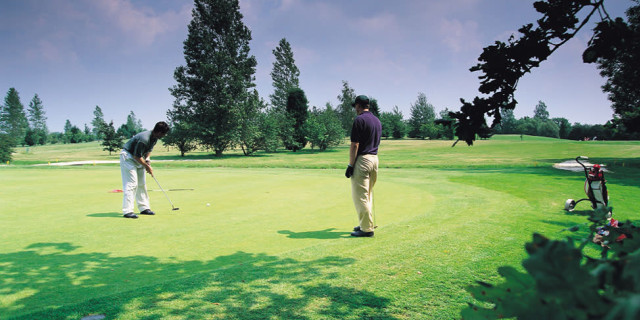
Golfers Are Optimistic About Future of UK Golf Clubs
THE year began with more golf course closures and plenty of warnings of more to come. And when the Prime Minister locked us down the future for club golf in the UK looked pretty bleak. Without membership revenue, without money being spent on food and drink, without money being spent in the pro’s shop, it seemed inevitable that we would see many more clubs closing their doors for the last time. Indeed, many predicted that they would never open again.
How wrong we all were. We have returned to the game in record numbers, with some golf clubs even having to open up waiting lists for the first time. So, in our August survey we asked if you were optimistic about the future of the club game - and 75.6% of you said that were, with just 6.2% answering in the negative. This is a very different picture and is one that should give us all hope.
Your views, which we feature below, are illuminating. While much of what we reproduce here is positive, there are still some worrying trends, with many of you believing that golf clubs still have much work to do. There is also a perception that dress code standards need to be relaxed and that the rules of golf remain too complicated - and that is without considering the new World Handicap System:
"Some clubs are run with the right intentions for the golfer but sadly some club owners are just about the money and don't provide the course in the proper condition for play, and some clubs are living on past reputations."
"With the rate that they are closing golf courses and banging up houses, I fear for the game. This is a small island and grossly over-populated, which doesn't bode well for the future of the game!"
"I hope that the lockdown doesn't force clubs out of existence due to staff being laid off and courses deteriorating."
“Golf is in 'good health' in the UK but the cost is increasing and that does concern me.”
"The municipal courses are under threat due to the high cost to local authorities of the Covid-19 pandemic coupled to indifferent management and promotion of golf at the courses owned and run by them."
"When redundancy kicks in, the casual golfer will disappear, and clubs will return to struggle mode."
"Golf clubs need to change, too many silly club rules that need to change with the times. I'm not sure how a strict dress code at a local club entices new players."
"Visitor green fees in my area are at least £5 higher than before lockdown. This will put some people off playing.”
“It's a dying sport. Football, cycling, and running are kings because they are easier to do for a lazy young generation.”

There is still widespread concern that not enough young people are playing, despite the fact that many clubs offer cheaper membership for those in the 20-35 age bracket, and minimal fees for children and teenagers:
"Demographics getting older, not enough youngsters getting involved."
"I still believe golf clubs have outdated models that mean most clubs skew older in age. Clubs aren’t doing enough to encourage a more diverse age profile into their club. Also, not enough diversity in golf full stop which is a worry The youngsters need more encouragement to play; seems they find the game very expensive and time consuming."
"Young people aren’t playing to the extent they once did. Golf is too expensive and takes too much time. This is not about slow play. The main issue is the obsession with 18-hole games and the tradition that all competitions must be 18 holes. If we wanted to promote a game which took less time - say two hours, - then we would focus more on nine-hole games. But the traditions within golf are too strong and the game will die before it recognises this."
"Numbers are falling. Money is disappearing. Golf clubs are poor at attracting juniors and women."
“Golf will die if new players (i.e. kids) aren't brought in. That doesn't mean abandoning rules and formats but welcoming kids and cutting them some slack with clothing and access. Free golf for juniors now means green fee-paying adults in the future."
"There’s always uncertainty for golf. Golf clubs still need to modernise and meet the demands of new younger golfers rather than going with the norm. We’re all paying customers after all. Older members are imperative to the club as their loyalty and memberships keep the courses alive - however listen to the younger members as they’re the future."
"Depends on those in authority making the game more attractive to the younger generation. The first step is to make the professionals play faster. They are role models for the younger people who could take up the game and those same younger people question why the pros take so long to play a shot. They don't want to spend up to five hours playing a game!"
"Cubs need to be more accessible to children, encouraging them to come and play from a very young age. I don't find any clubs inviting for children and there's still a snobbish culture in golf which needs to go. I've been playing golf on and off over 20 years and I still find those who have all the gear and no idea can have a bad attitude towards new players or players who don't spend as much on the gear. Regarding children, clubs should encourage them (at certain specified times) to come and play with parents and not be pressured by other golfers to speed up. Let them tee off, pick up and drop near the green, chip on and putt. Why not? They'll learn to love the game. Par 3 courses are generally in a crap condition so there's no excuse of getting kids on those to experience a proper game."

It is obvious that there is a clamour for change when it comes to the cost and types of membership on offer and attitudes towards new golfers. And many of you still see golf clubs as being an unwelcoming environment for new members. There are also still concerns about accessibility and the cost of the game:
"We need to come away from traditional memberships as this deters new golfers taking up the sport and opens up an easier pathway to getting started.”
"Expensive green fees. Clubs unwelcoming towards visitors. Outdated rules (clothing requirements, 28 or lower handicap required to play) all seem very off-putting to new and inexperienced golfers."
"The pandemic has created a possibly temporary relief - tee times have mean that some members can now easily play more, to the detriment of the playing opportunities of golfers who can only play once or twice a week (at most) - 25% of the working population were on a paid holiday - the rest (non-essential) adapting to working form home, which meant less traveling so more time to play. But this is all economically unsustainable - few clubs did anything about giving everyone the same initial access to 'peak' tee times - golf was far too busy patting itself on the back."
"Golf seems to be more popular than ever. I can’t get a tee time at my club this weekend before 4pm. You need to book almost two weeks ahead now to get a decent weekend tee time. The club had reported more new members this year than for a long time."
"The increase in the numbers playing golf in our wider area is very evident. The change in work patterns is a major factor, which could continue. Our club has received 170 new memberships and has closed entry. So good for us."
“Lockdown has given a temporary boost to some clubs, which for some will not last, especially those asking for higher green fees currently."
"We have had 180 new members this year- half had a special deal. Hopefully some/most will renew next year."
"It has proved a great help for mental wellbeing during this time. But it needs to be more accessible as green fees are still prohibitive to individuals & families on low incomes."
"I think what we have learnt during this difficult time is that Golf is one of the best sports to play during this crisis as it is safe to do, good for exercise and mental wellbeing. Also, out in the fresh air and seeing the wildlife is just the best place on earth during a world pandemic."
"Optimistic that I will be able to continue to play and enjoy golf. I doubt participation levels will hold at this level - golf is too expensive and too hard for the masses."
"The golf side is busy, however it is the social side that pays some 50% of the costs of running a club if the fees are not to rise out of control.”
"What is alarming for me is how expensive golf has become, to play as a visitor at many courses. It feels like golf is taking advantage of people being desperate to participate in any activity whatever that may be, and overcharging. I paid what I consider to be quite a lot for a green fee at a municipal course, and the fairways were like light rough."
"With the lockdown I hope the clubs do not start getting greedy and increase prices because golfers will leave the sport or go to pay and play.”
It is interesting that while so many of you are optimistic about the future of the club game, there are still so many areas of concern - not enough youngsters, cost, trouble booking tee times, a belief that many new members will walk away, outdated dress codes, complicated rules. And yet we have seen near-record numbers of rounds playing during the summer of 2020. The acid test will come when winter arrives, it gets dark at 4pm and the frosts set in.
Related Content
Are These the Issues Golf Clubs Still Need to Address
6 Things Your Golf Club Must Do in 2020
What Golf Needs to Change in the 2020s
What Made Golfers Play More This Summer
The Reasons Golfers Joined Golf Clubs in Record Numbers
Tags: Memberships industry insider Green Fees Golf Clubs daily picks









